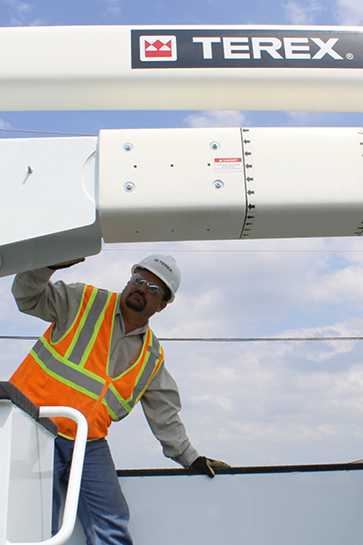Part 1 - Troubleshooting Tips When Insulated Booms Fail Dielectric Testing
Insulated aerial devices and digger derricks may provide secondary protection to help protect workers who follow proper work practices from electrocution. For this reason, dielectric testing is critical to verifying that the insulated portion of the machine is functioning as expected.
When Dielectric Testing is Needed
A new boom is dielectric tested following the requirements of ANSI for a Qualification test at the factory to determine the insulation rating. The installer will then perform a dielectric test to confirm the insulation after units are installed, finished, and operational. Once insulated equipment is placed in service, maintenance tests are required to be performed for a variety of reasons. Periodic annual testing in accordance with ANSI A92.2 or A10.31 standards is required. If the equipment has not had a dielectric test performed within the last 12 months, as required by ANSI and OSHA, it cannot be considered insulated. Dielectric testing should also take place after repairs or replacement of components in the insulated sections, or when a problem is suspected, or after incidents of contact with energized power lines. If the fiberglass boom is replaced, the original qualification test is no longer valid. A new qualification test is required after reassembly before returning to service.

What Causes Testing Failure
Environmental factors can affect the results of a dielectric test. Environment of use, exposure to sunlight, condition, damage, and cleanliness of the boom and internal components could lead to dielectric test failure. When this happens, qualified personnel should try these troubleshooting steps before re-testing the insulated fiberglass components.
Inspect, Cleaning and Drying the Boom
First, make sure the insulated portion of the boom is free from scars, gouges, scuff marks and wear pad marks, and is clean inside and out. Begin by cleaning the external boom thoroughly with a non-abrasive cleaner such as Simple Green and a fine abrasive Scotch Brite Pad.
Next, inspect the interior of the boom looking at the hoses and leveling rods. Identify any hydraulic leaks and correct as necessary. Clean out any debris. Wash the interior surface of the boom with soap, but do not use detergents as they will remove the wax on the interior of the boom. Be careful to not apply water pressure to the hoses, which could strip the jackets off the hoses. Flush with clean water to remove residue. Note, never use steam to clean the boom as this will damage the hoses, remove the interior wax and cause water to be absorbed into the fiberglass boom.
Finally, position the boom to drain the water and allow the boom to dry for a minimum of 24 hours in an environment with more than 25 percent humidity and a minimum temperature of 60° F.
Test It Again
After inspecting, cleaning, and drying the boom, perform the dielectric test again. If it fails, verify that the test equipment is working properly, and set-up procedures are correctly followed before re-testing. If the unit still fails to pass the dielectric test, the problem must be identified by process of elimination.
In the next article from Utility Pros, we will cover what to do if the dielectric test fails after inspection and cleaning.
Terex Utilities Tech Tips provide additional insight into frequently asked questions that our service representatives receive. Tech Tips are a supplement to service manual instructions. The information in this article is taken from Tech Tip #51.

.png?sfvrsn=cfc0900d_0)